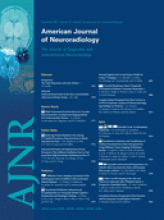Abstract
BACKGROUND AND PURPOSE: Hypertension, one of the most important risk factors for strokes, is associated with altered arterial anatomy and function. In this study, we compared the visualization of the LSAs by 3T 3D-TOF-MRA and DSA and quantitatively examined the LSAs in patients with hypertension by using 3D-TOF-MRA.
MATERIALS AND METHODS: We first examined 126 patients with 3D-TOF-MRA and DSA and determined the number of LSAs. In addition, we examined 60 patients with hypertension and 60 nonhypertensive volunteers with 3D-TOF-MRA and determined the quantitative differences between the LSAs of these 2 groups.
RESULTS: The mean number of LSA stems visualized by DSA and 3D-TOF-MRA on 1 side was 4.1 ± 0.74 and 3.9 ± 0.94, respectively (P = .0617). The average number of LSA stems on both sides was 4.7 ± 0.8 in patients with hypertension and 6.3 ± 1.9 in nonhypertensive volunteers (P < .0001). The mean number of LSAs in the young hypertensive group (<50 years of age) and its age-matched nonhypertensive group was 4.8 ± 1.1 and 7.6 ± 1.2, respectively (P < .0001) and that in the old hypertensive group (≥50 years of age) and its age-matched nonhypertensive group was 4.6 ± 0.9 and 5.0 ± 1.0, respectively (P = .1088).
CONCLUSIONS: LSA detection showed good correlation between 3T 3D-TOF-MRA and DSA. As determined by 3D-TOF-MRA, there was a significant decrease in the number of LSA stems in patients with hypertension compared with that in nonhypertensive volunteers; moreover, the difference in young subjects was more than that in the elderly.
Abbreviations
- ACA
- anterior cerebral artery
- BP
- blood pressure
- CTA
- CT angiography
- DSA
- digital subtraction angiography
- LSA
- lenticulostriate artery
- MCA
- middle cerebral artery
- MOTSA
- multiple overlapping thin-slab acquisition
- MRA
- MR angiography
- 3D-TOF-MRA
- 3D time-of-flight MR angiography
- MIP
- maximum intensity projection
- SENSE
- sensitivity encoding
- SLINKY
- sliding interleaved Ky
- TONE
- tilted optimized nonsaturating excitation
- © 2011 by American Journal of Neuroradiology
Indicates open access to non-subscribers at www.ajnr.org












